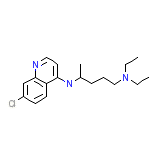Aralen HCl




Categorie
Aralen HCl Les marques, Aralen HCl Analogs
- 3377 RP opalate
- Amokin
- Aralen
- Aralen HCl
- Arechin
- Arthrochin
- Artrichin
- Avlochlor
- Avloclor
- Bemaco
- Bemaphate
- Bemasulph
- Benaquin
- Bipiquin
- Capquin
- Chemochin
- Chingamin
- Chloraquine
- Chlorochin
- Chlorochine
- Chloroquina
- Chloroquine (VAN)
- Chloroquine Phosphate
- Chloroquinium
- Chlorquin
- Cidanchin
- Clorochina
- Cocartrit
- Delagil
- Dichinalex
- Elestol
- Gontochin
- Heliopar
- Hydroxychloroquine Sulfate
- Imagon
- Iroquine
- Klorokin
- Lapaquin
- Malaquin
- Malaren
- Malarex
- Mesylith
- Neochin
- Nivachine
- Nivaquine
- Nivaquine B
- Nivaquine [as sulfate]
- Pfizerquine
- Plaquenil
- Quinachlor
- Quinagamin
- Quinagamine
- Quinercyl
- Quingamine
- Quinilon
- Quinoscan
- Resochen
- Resochin
- Resoquina
- Resoquine
- Reumachlor
- Reumaquin
- Roquine
- Sanoquin
- Silbesan
- Siragan
- Solprina
- Sopaquin
- Tanakan
- Tresochin
- Trochin
Aralen HCl Les marques melange
Aralen HCl Formule chimique
C18H26ClN3
Aralen HCl RX lien
http://www.rxlist.com/cgi/generic2/hquine2.htm
Aralen HCl FDA fiche
Aralen HCl msds (fiche de securite des materiaux)
Aralen HCl Synthese de reference
Aucune information disponible
Aralen HCl Poids moleculaire
319.872 g/mol
Aralen HCl Point de fusion
289 oC
Aralen HCl H2O Solubilite
10,6 mg / L
Aralen HCl Etat
Solid
Aralen HCl LogP
4.474
Aralen HCl Formes pharmaceutiques
Tablet
Aralen HCl Indication
Pour le traitement suppressif et de crises aiguës de paludisme à P. vivax, P. malariae, P. ovale et des souches sensibles de P. falciparum, l'agent de deuxième ligne dans le traitement de la polyarthrite rhumatoïde
Aralen HCl Pharmacologie
La chloroquine est le prototype de médicament anti paludisme, la plus largement utilisée pour traiter tous les types de paludisme, sauf pour les maladies causées par la chloroquine de Plasmodium falciparum résistant. Il est très efficace contre les formes érythrocytaires de Plasmodium vivax, Plasmodium ovale et Plasmodium malariae, les souches sensibles de Plasmodium falciparum et des gamétocytes de Plasmodium vivax. Etre alcalin, le médicament atteint forte concentration dans les vacuoles alimentaires du parasite et soulève son pH. Il se trouve à induire l'agglutination rapide du pigment. La chloroquine inhibe l'enzyme polymérase parasitaires hème qui convertit l'hème toxiques dans non toxique hemazoin, ce qui entraîne l'accumulation de toxiques dans l'hème du parasite. Il peut également interférer avec la biosynthèse des acides nucléiques.
Aralen HCl Absorption
Complètement absorbé par les voies gastro-intestinales
Aralen HCl Toxicite
Aucune information disponible
Aralen HCl Information pour les patients
PATIENT INFORMATION
Complete blood cell counts should be made periodically if patients are given prolonged therapy. If any severe blood disorder appears which is not attributable to the disease under treatment, discontinuance of the drug should be considered. The drug should be administered with caution to patients having G-6-PD (glucose-6 phosphate dehydrogenase) deficiency.
In patients with preexisting auditory damage, chloroquine should be administered with caution. In case of any defects in hearing, chloroquine should be immediately discontinued, and the patient closely observed.
Since this drug is known to concentrate in the liver, it should be used with caution in patients with hepatic disease or alcoholism or in conjunction with known hepatotoxic drugs.
Patients with history of epilepsy should be advised about the risk of chloroquine provoking seizures.
Because of the potential for serious adverse reactions in nursing infants from chloroquine, a decision should be made whether to discontinue nursing or to discontinue the drug, taking into account the potential clinical benefit of the drug to the mother.
Irreversible retinal damage has been observed in some patients who had received long-term or high-dosage 4-aminoquinoline therapy. Retinopathy has been reported to be dose related.
Follow Rxlist link and drugs.com link for detailed patient information.
Complete blood cell counts should be made periodically if patients are given prolonged therapy. If any severe blood disorder appears which is not attributable to the disease under treatment, discontinuance of the drug should be considered. The drug should be administered with caution to patients having G-6-PD (glucose-6 phosphate dehydrogenase) deficiency.
In patients with preexisting auditory damage, chloroquine should be administered with caution. In case of any defects in hearing, chloroquine should be immediately discontinued, and the patient closely observed.
Since this drug is known to concentrate in the liver, it should be used with caution in patients with hepatic disease or alcoholism or in conjunction with known hepatotoxic drugs.
Patients with history of epilepsy should be advised about the risk of chloroquine provoking seizures.
Because of the potential for serious adverse reactions in nursing infants from chloroquine, a decision should be made whether to discontinue nursing or to discontinue the drug, taking into account the potential clinical benefit of the drug to the mother.
Irreversible retinal damage has been observed in some patients who had received long-term or high-dosage 4-aminoquinoline therapy. Retinopathy has been reported to be dose related.
Follow Rxlist link and drugs.com link for detailed patient information.
Aralen HCl Organismes affectes
Plasmodium














